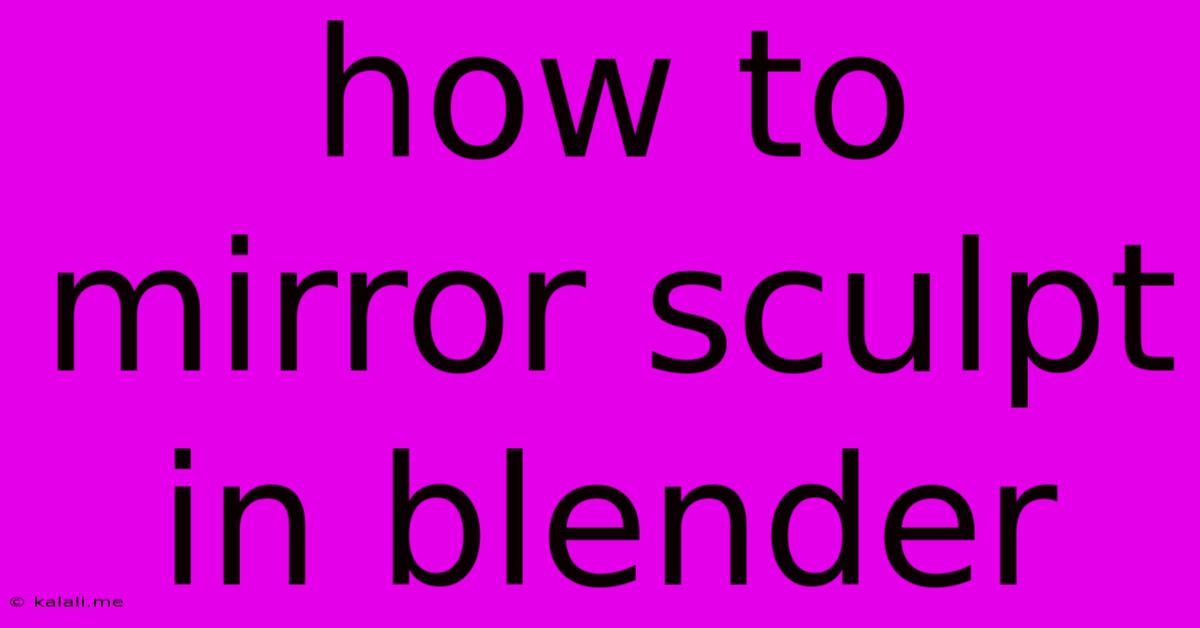How To Mirror Sculpt In Blender
Kalali
Jun 01, 2025 · 3 min read

Table of Contents
Mastering Mirror Sculpting in Blender: A Comprehensive Guide
This guide provides a comprehensive walkthrough on how to effectively utilize Blender's mirror modifier for sculpting symmetrical models, saving you time and effort while achieving professional-looking results. Whether you're sculpting a character, creature, or object, understanding mirror sculpting is crucial for efficient workflow. We'll cover setup, troubleshooting common issues, and advanced techniques to elevate your sculpting game.
What is Mirror Sculpting?
Mirror sculpting in Blender leverages the Mirror modifier to create perfectly symmetrical models. You sculpt on one half, and the modifier automatically reflects your changes to the other side, ensuring perfect symmetry. This dramatically reduces sculpting time and guarantees consistency across both sides of your model. This technique is essential for creating characters, animals, vehicles, and any other model requiring mirrored geometry.
Setting up Your Mirror Modifier
-
Create your base mesh: Begin with a basic mesh, like a sphere or cube, depending on your desired sculpt. Ensure your mesh is centered at the origin (0, 0, 0) for optimal mirroring.
-
Add the Mirror Modifier: Select your base mesh, go to the Modifiers tab (wrench icon), and click "Add Modifier" -> "Mirror".
-
Axis Selection: Choose the axis around which you want to mirror. For most symmetrical sculpts, this will be the 'X' axis. This defines the plane of symmetry.
-
Merge & Clipping: These are crucial settings.
- Merge: Selecting "Merge" will join vertices at the mirror plane, preventing seams. This is essential for clean symmetrical models.
- Clipping: Enable "Clipping" to constrain sculpting to one side of the mirror plane. This prevents accidental sculpting on the mirrored side, maintaining symmetry.
-
Sculpting: Now you can start sculpting on one side of your model. Remember, only sculpt on one side; the other will automatically mirror your actions.
Advanced Techniques & Troubleshooting
-
Topology: Clean topology is vital for seamless mirroring. Avoid uneven polygon distribution, especially near the mirror plane, as this can lead to artifacts.
-
Subdivision Surface Modifier: Always use a Subdivision Surface modifier above the Mirror modifier in the modifier stack. This ensures smooth sculpting and prevents issues with sharp edges appearing at the mirror plane.
-
Clipping Issues: If your sculpt unexpectedly extends beyond the mirror plane, ensure that clipping is enabled and that your mesh is correctly centered.
-
Asymmetry: If your mirrored half seems slightly off, it may be due to uneven topology, or it may be a bug involving a complex mesh. Troubleshooting this usually involves simplification of the geometry and repositioning the object.
-
Symmetry adjustments: Sometimes you might need slight asymmetry. You can achieve this by temporarily disabling the mirror modifier to work on specific areas. Remember to re-enable it afterward.
Optimizing Your Workflow
-
Reference Images: Utilize reference images to maintain accuracy and consistency during your sculpting process.
-
Regular Saves: Frequently save your work to prevent data loss.
-
Dynamic Topology: Leverage Blender's Dynamic Topology for quick and efficient sculpting, especially during initial blocking phases.
-
Retopology: After sculpting, consider retopologizing your high-poly sculpt to create a low-poly, game-ready mesh.
Conclusion
Mirror sculpting in Blender is a powerful tool that significantly streamlines the sculpting process. By mastering the techniques outlined in this guide, you can create highly detailed and symmetrical models efficiently. Remember to experiment with different settings and techniques to find your preferred workflow, and remember that consistent practice will enhance your skill in this invaluable 3D modeling technique.
Latest Posts
Latest Posts
-
Soluti9ns Water Overflows Gutter At Corner
Jun 02, 2025
-
How To Remove Rust From Bathtub
Jun 02, 2025
-
Difference Between Sell To Open And Sell To Close
Jun 02, 2025
-
What Type Of Distortion Does The Gall Peters Projection Preserve
Jun 02, 2025
-
Can You Reach Over The Net In Volleyball
Jun 02, 2025
Related Post
Thank you for visiting our website which covers about How To Mirror Sculpt In Blender . We hope the information provided has been useful to you. Feel free to contact us if you have any questions or need further assistance. See you next time and don't miss to bookmark.